Apple MacBook Pro's Liquid Retina XDR Display Review
After looking at the functioning of Apple'due south M1 Pro SoC powering the new MacBook Pro 16, and beyond reviewing the laptop itself, there'due south another interesting component in this laptop that's worth looking into, and that'south the mini-LED 120Hz display. And so today nosotros're going to have a closer look at what Apple is doing with their brand new screen.
As y'all're fully aware, we have a lot of experience testing and reviewing displays, however we mostly cover gaming monitors non laptop displays, so this is going to be a piffling unlike. We're going to run through some tests and provide our thoughts on how practiced this display is as someone that looks at lots and lots of displays each year.
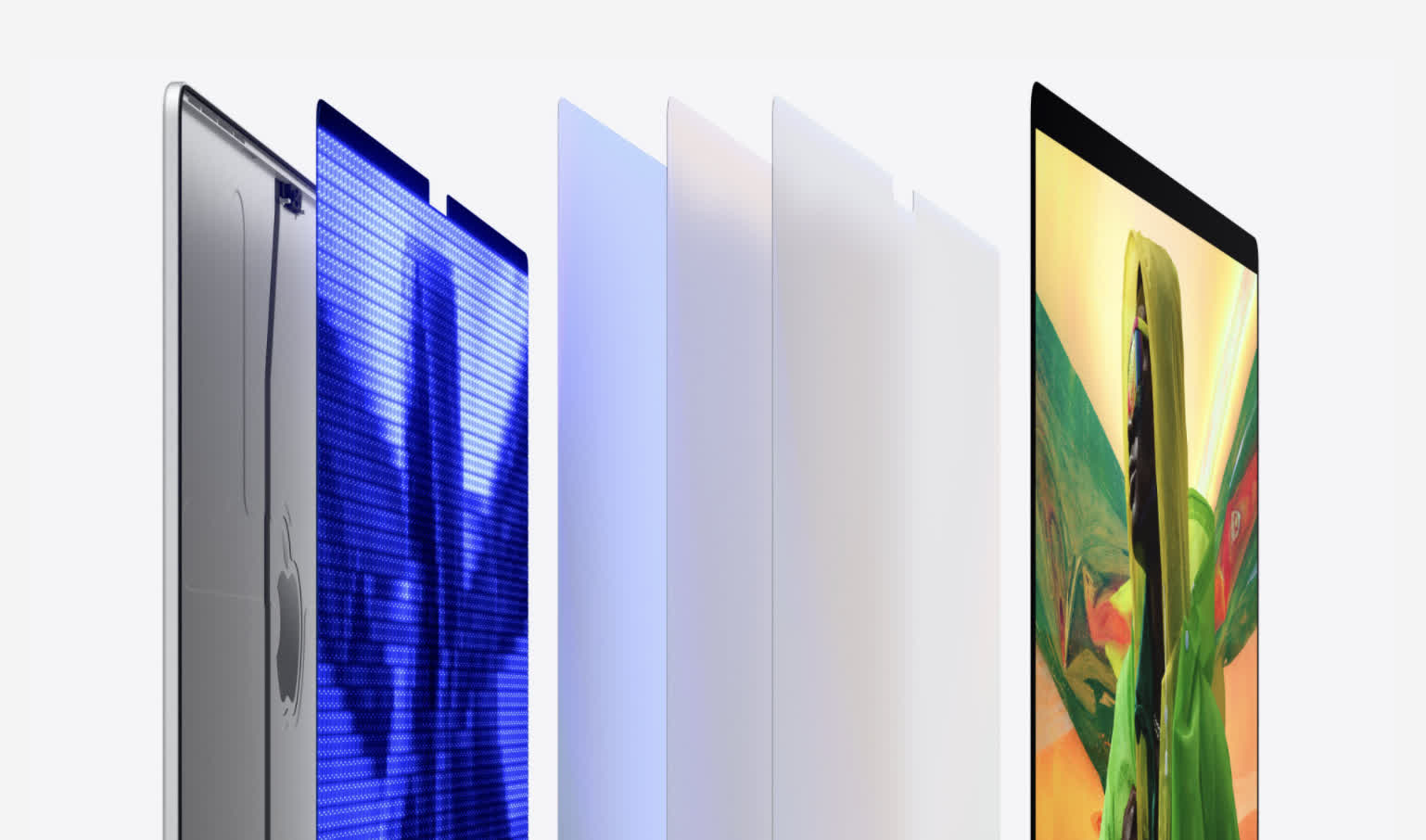
There are two versions of the new MacBook Pro and we've got the xvi-inch version, although the 14-inch model's display is very like but smaller and with a unlike resolution. Apple calls this particular display a "Liquid Retina XDR display" which is typical Apple marketing speak. If I interpret this into what Apple really means, they are giving you a loftier resolution full assortment local dimming mini-LED LCD with truthful HDR functionality.
If we dive deeper into the specs, the 16.2-inch console has a resolution of 3456 10 2234 which continues Apple's tradition of using non-standard resolutions beyond their line-up. Apple doesn't disembalm the exact technology used here, simply information technology's an LCD console which appears to be IPS-similar in pattern. The backlight has ten,000 mini-LEDs for impressive zone density at this size, allowing for a contrast ratio of one,000,000:1 and height brightness upward to 1,600 nits in the HDR mode on newspaper.
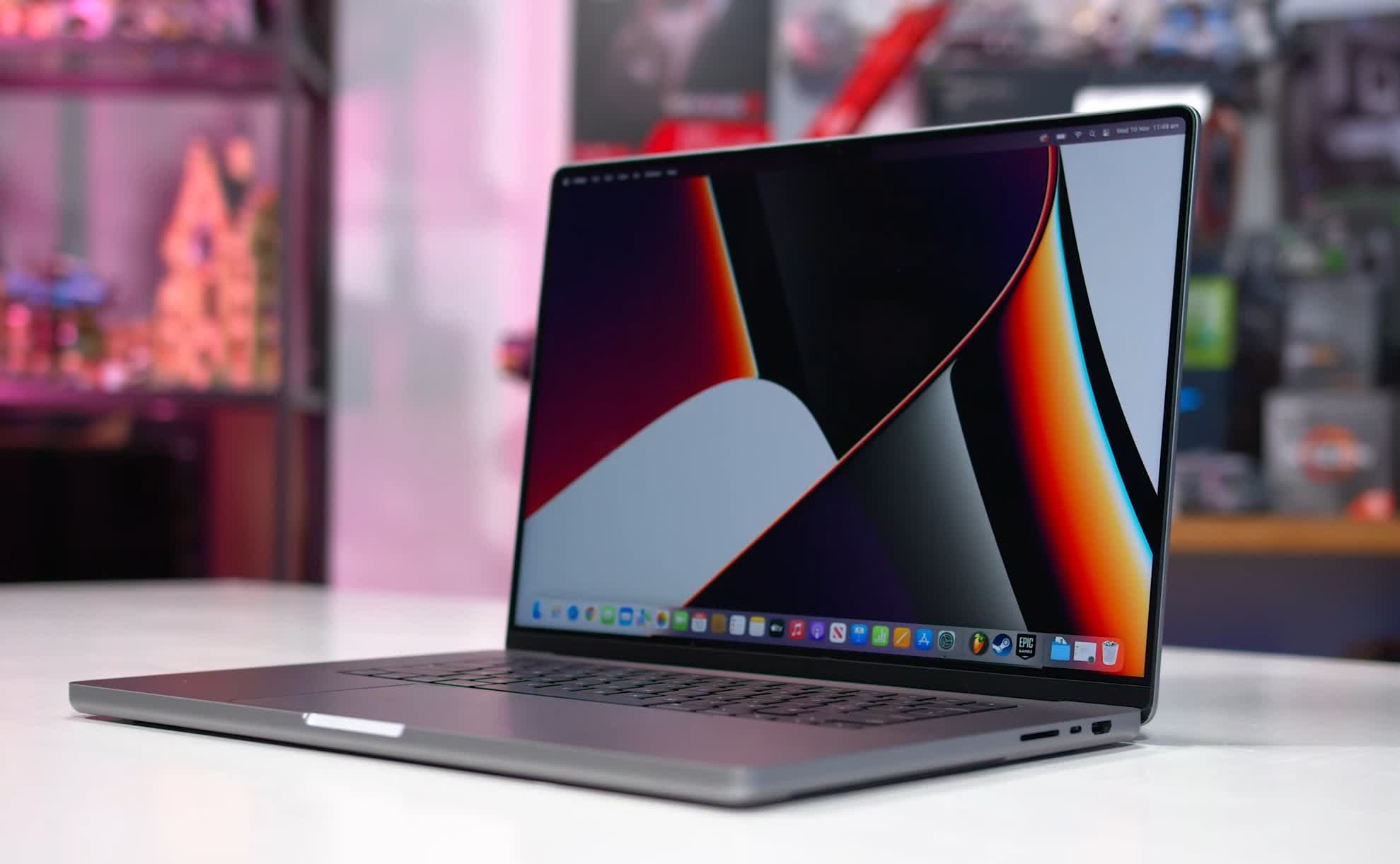
As for refresh rate, Apple are offering up to 120Hz with adaptive sync, which they've rebranded into "ProMotion" although this sort of functionality has been available for many years now in other laptops and displays. The combination of everything though is a start, and the only rivals to this sort of panel are the latest wave of 4K OLED panels seen in a few high-end Windows laptops.
Patently, a big talking point has been including a notch in the display. Apple tree claims this was necessary to decrease bezel size and increase the display real estate while retaining the webcam at the meridian, though I'1000 not so sure that's true. The notch is admittedly massive relative to the size of the camera and sensors, and looks kind of ridiculous. I mean, surely this could take been smaller? Only at least I'g glad Apple didn't put the webcam below the display.
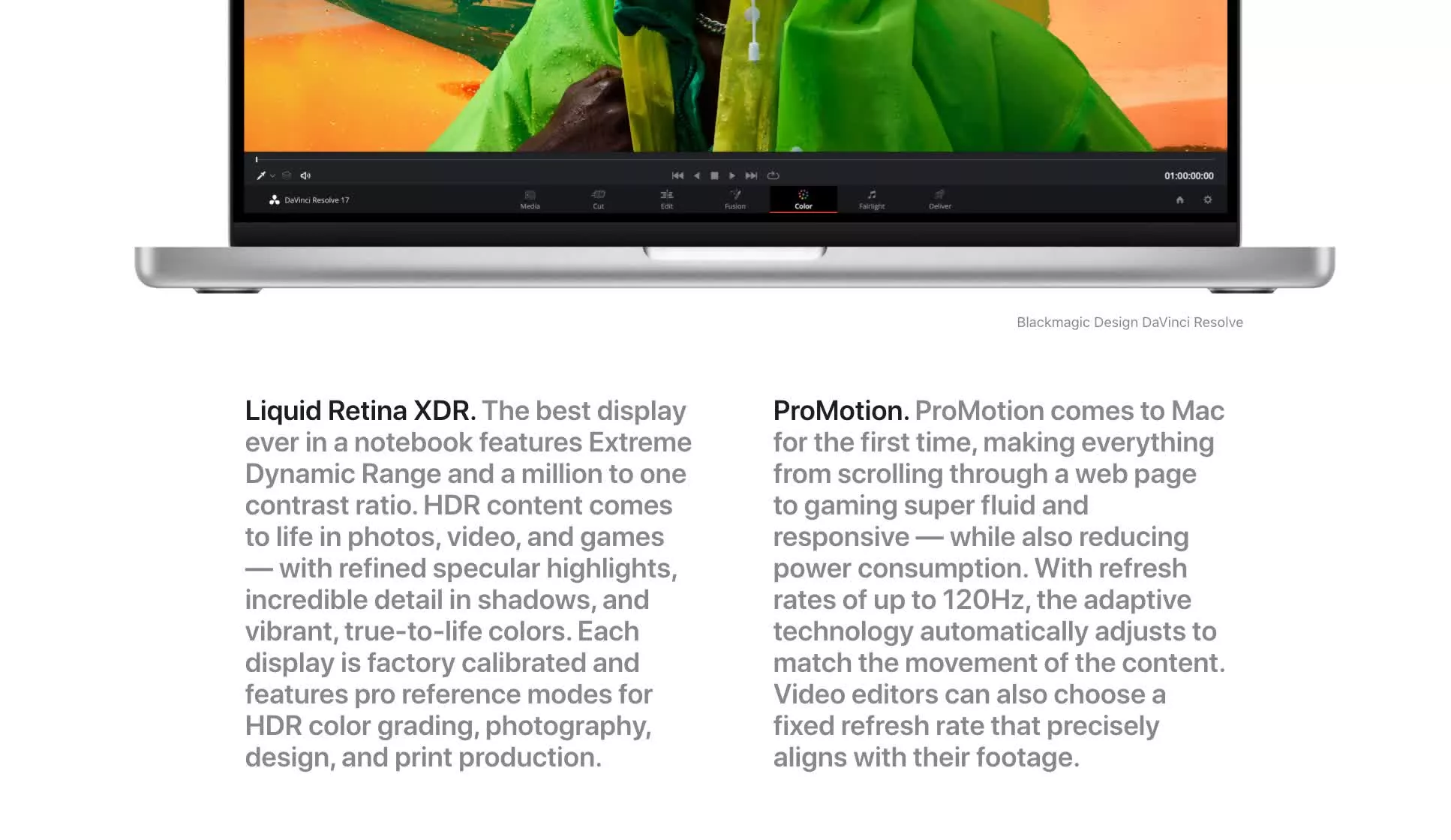
I don't want to dwell on the notch too much as in practice using the laptop information technology's not that big of a bargain. Let's take a look at how the Liquid Retina XDR display really performs and I'm going to outset here with some colour performance results because I call back these are virtually relevant to a creator-focused display like this. I'll get to talking about response performance later.
Color Performance
Color Space: Apple MacBook Pro sixteen XDR Brandish - D65-P3
The MacBook Pro'south display is a wide gamut brandish with 99% coverage of the DCI-P3 colour space. That'south an fantabulous result for any creator looking to produce content in that gamut. This likewise means perfect sRGB coverage, and so if you're designing web content, creating SDR videos, or working with broad gamut HDR videos then Apple is providing you the tools to do that.

Unfortunately the performance outside these gamuts is not cracking, specifically what's missing is Adobe RGB coverage which is relevant for photography work. Due to covering P3 fully we do get over 90% Adobe RGB coverage, simply information technology's missing the top range of greens that differentiate Adobe RGB from other colour spaces, so this laptop isn't suitable for that sort of work. Apple too knows this, because they don't provide an Adobe RGB colour profile, while you do get various P3 and Rec. 709 profiles.
Colour Space: Apple MacBook Pro 16 XDR Display - Adobe RGB
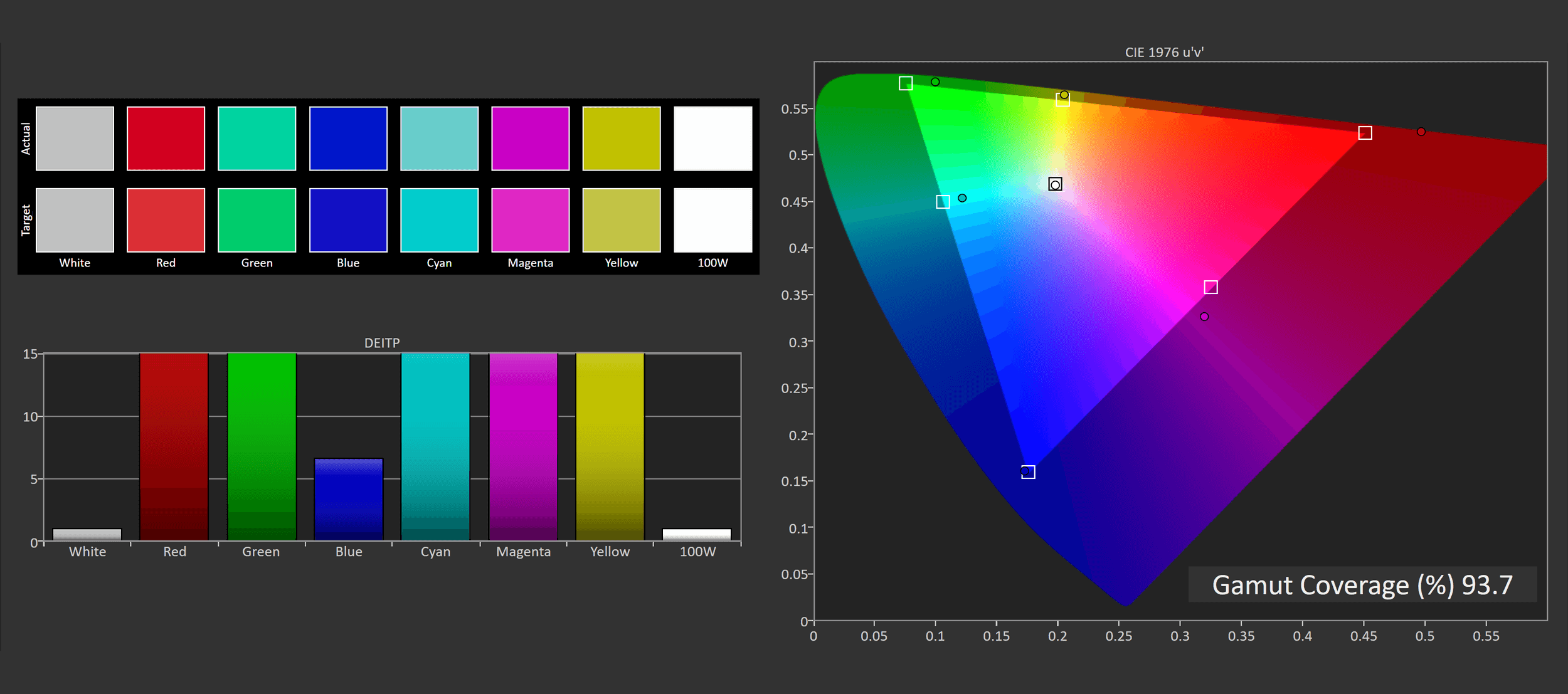
Where the MacBook Pro's display ends up in terms of color gamut is typical for a modern "creator" laptop, the majority of peak-cease laptop displays have really expert coverage of sRGB and P3. Where it falls a little short is in that Adobe RGB coverage, and a competing display like the Samsung OLED you make it devices such as the Gigabyte Aero xv OLED does offer a wider color gamut with total Adobe RGB coverage. That's non to say the MacBook Pro's gamut is bad or anything, information technology's only non as wide or as versatile every bit I've seen.
Mill Calibration
Where the display is extremely impressive is in its colour calibration, and this is helped significantly past macOS doing a much better job of color management than Windows. The various color profiles included by default work across far more apps in macOS than they would on Windows and this is one surface area where Windows needs a bit of an overhaul.
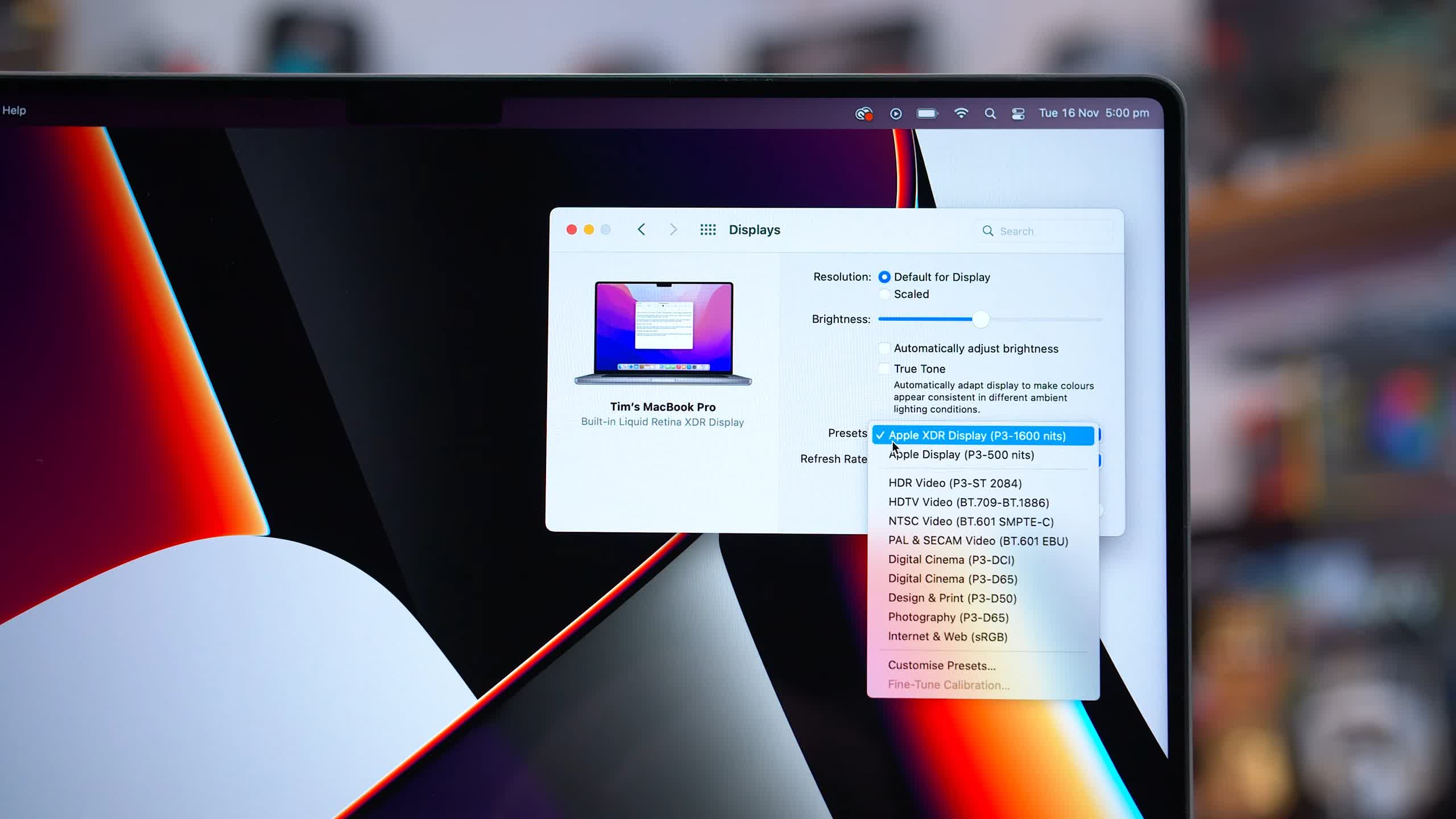
If we wait at the options provided in the MacBook Pro's display settings, you'll find quite a few options including Apple Brandish and Apple XDR Display presets, along with a decent array of creator focused modes for gamuts like BT.709, sRGB and P3. Apple also offers True Tone and Night Shift functionality, which some people might find useful but ultimately injure color accuracy. I've disabled True Tone for testing.
Default Colour Performance: Grayscale, Saturation and ColorChecker



When looking at the default Apple tree Brandish contour, performance is pretty good by default. When displaying sRGB content in this manner, information technology's quite likely color management will activate in the app you're using to display the content correctly and accurately, instead of oversaturating it up to the full P3 gamut of the screen. When looking at saturation sweeps as an case, we find excellent deltaE performance, and practiced results in ColorChecker as well, specially around pare tones which are crucial to become correct.
Greyscale performance was too solid, my laptop didn't quite hit a 6500K color temperature but came close, and sRGB gamma was being displayed equally apartment 2.2 instead of using the sRGB role, just these problems are pocket-sized and overall performance was very solid.
Based on this you should probably just go out your MacBook in the Apple Display mode for everyday use as it'due south accurate enough for sRGB content and will likewise let you benefit from broad gamuts where needed. The performance in the Apple Display XDR style is like as well for SDR content, and then that's an selection if you want to also employ HDR at times.
sRGB Style: Grayscale, Saturation and ColorChecker



If you want even improve color accurateness, Apple tree's included profiles might exist for you. For example, the built-in sRGB mode is even better at displaying sRGB content, with accurateness equivalent to performing a total calibration yourself.
I suspect the reason why this mode is ameliorate than the default mode is that it's specifically tailored to showing sRGB content, rather than the more general default mode that is designed for use in multiple scenarios. Color management is hard and creating specific modes for each gamut is generally the best approach, so it's keen Apple has done this for you.
Rec. 709 Mode: Grayscale, Saturation and ColorChecker
I tried a couple of the other modes as well, here is the BT.709 mode which is perfect for mastering SDR video content. Accuracy is smashing, not quite as good equally the sRGB mode but still excellent for content creation with confidence that it'southward correct. Apple tree too does a decent job with the DCI-P3 style if yous demand to create video content in that color space, nailing the green-tinted white indicate and delivering decent gamma except for 1 flaw in the depression gamma range.




DCI-P3 Mode: Saturation and ColorChecker


There is a downside to these modes, and that'due south locked brightness. At present technically each of these colour specifications do stipulate a brightness level for mastering: sRGB is 80 nits, DCI-P3 is 48 nits and Rec. 709 is 100 nits – and the MacBook Pro gets this right.
However that limits the usefulness of these modes for viewing content, where the mastering effulgence level is less relevant and your ambient conditions are more important. I'd like to see a brightness override toggle, and then that each of these modes is still useful for mastering, merely can besides evangelize the best accuracy for watching other content. That would amend the versatility of the display and give you the ability to fine melody accurateness across the already very good default mode.
Effulgence and Dissimilarity
In the regular Apple Brandish manner for viewing SDR content, I measured peak effulgence at effectually 520 nits, with a variable blackness level. Bizarrely, the MacBook Pro appears to modify its black level limit in the SDR mode depending on the ambience light atmospheric condition, even with True Tone disabled. In a lit room, the black level was capped to 0.02 nits, delivering effectually a 26,000:1 contrast ratio.
SDR Fashion Brightness (sRGB)

Even so when testing in a dark room, which is how we ordinarily test, the black level halved to around 0.01 nits, increasing the contrast ratio to virtually l,000:i. This could be consistently replicated by covering or uncovering the camera and sensors in the notch. I honestly take no idea why Apple would command the display in this mode, it's a pretty small alter all things considered, so it must be benign to something, just we have no idea on that one.
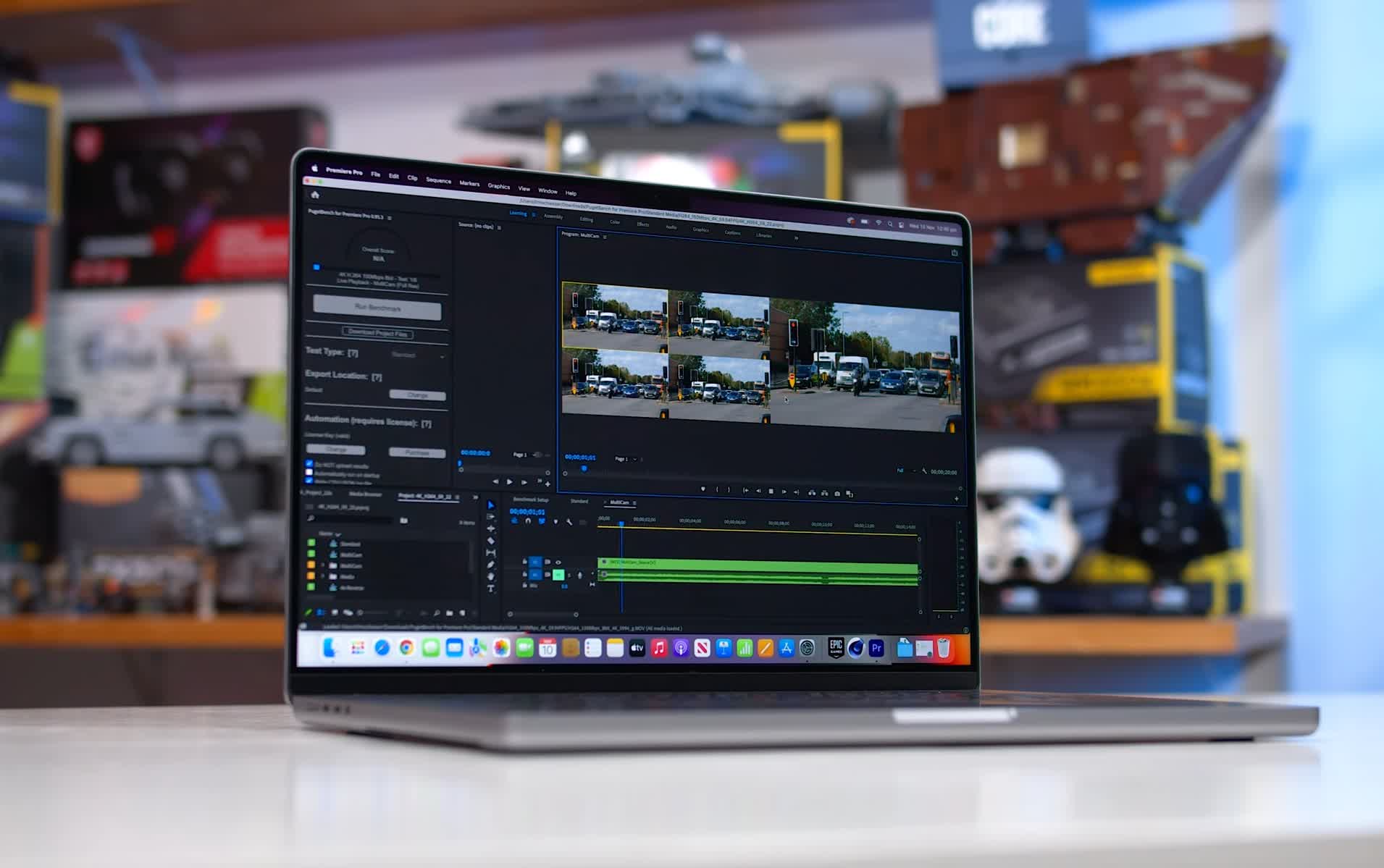
In any case, the mini-LED backlight is active at all times, even in SDR content, to amend the contrast ratio in SDR scenes. There are and then many zones here that it's unlikely y'all'll spot much blooming in practice, I found it negligible for SDR use even in tricky desktop apps with harsh edges between light and dark areas. The dimming algorithm is tweaked nicely to avoid this situation and there are simply more than enough zones to preclude lingering issues. This sort of attention to detail is what I'd dear to see more than in the standalone monitor space, along with college zone counts, of course.
HDR Performance
In the HDR mode, effulgence is extremely impressive. In that location'due south no major difference between sustained and pinnacle effulgence, and so at that place's no automatic effulgence limiter that activates after a curt menstruum to dim the screen in intensely brilliant scenes. Brightness is as loftier as 1670 nits at small-scale window sizes, and over 1500 nits at l%, before dropping to effectually 1150 nits for a total screen sustained white window. That'southward impressive, although it does come with a corresponding increase to power consumption, and so running the display at over g nits all the time isn't appropriate on battery.
HDR: Brightness vs. Window Size

Dissimilarity beliefs is as well dissimilar in HDR compared to SDR. When displaying HDR content, the mini-LED backlight will, at times, fully switch off to display black, delivering an effectively space contrast ratio. That's the best case functioning yous'll see. In more tricky conditions, such as a checkerboard test or measuring low-cal and dark areas close together, I measured a contrast ratio of slightly over 50,000:1. This is right where you'd want functioning to be for HDR content, contrast ratios of 50,000:1 worst example and upwards to 1,000,000:i or greater in other situations. Apple tree are meeting all the recommendations for performance that I've heard when speaking to HDR, calibration and mastering experts.
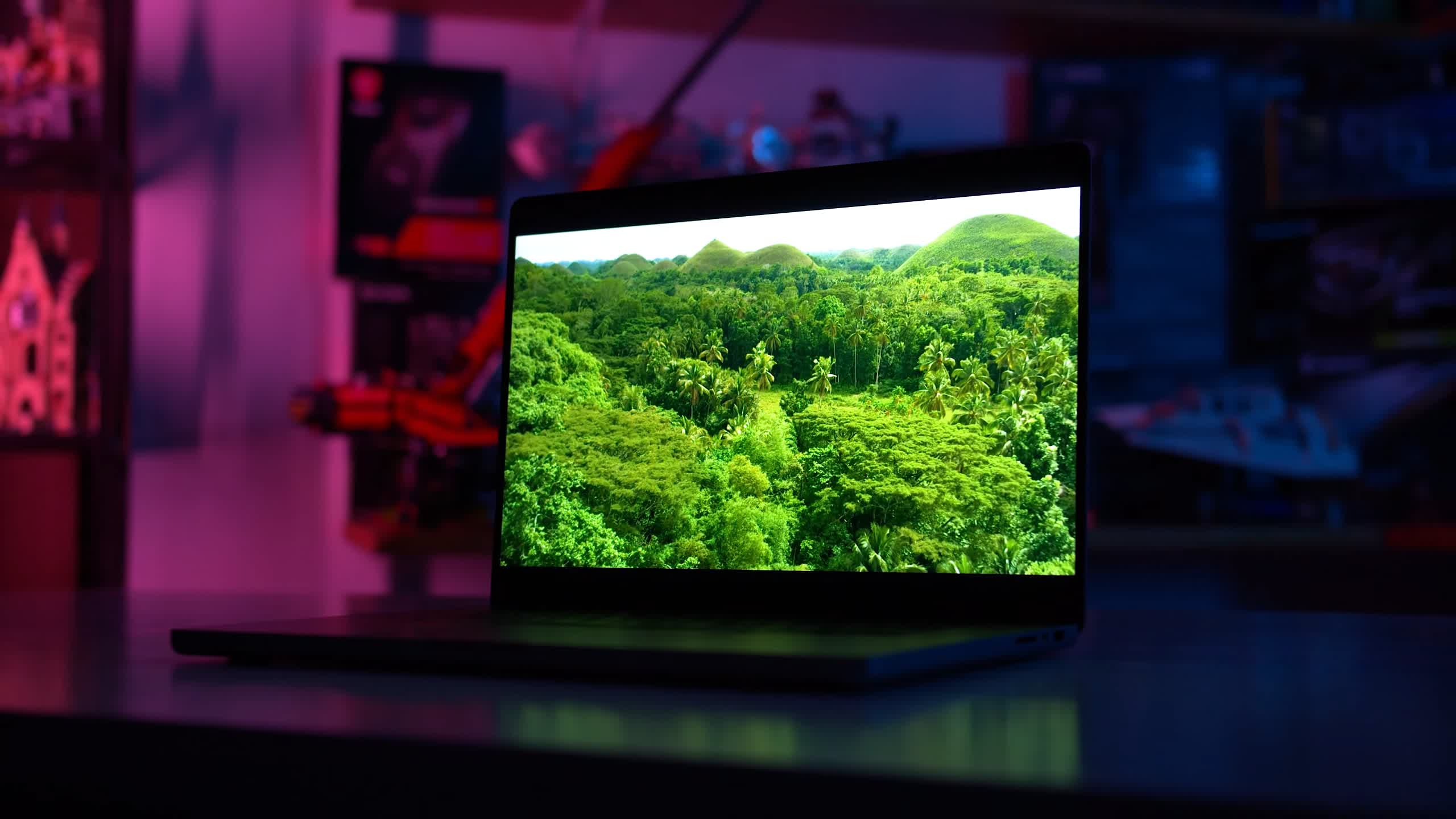
This performance also destroys basically any other LCD based monitor I've looked at before. On the standalone monitor side, it'southward almost unheard of correct now to see LCD zone counts higher than a couple of thousand. This limits worse instance contrast to around 12,000:one in the case of the 2,000-zone Samsung Odyssey Neo G9 with VA engineering, or simply 4,000:1 in a checkerboard test.
Apple tree choosing to use 5-10x the zone count massively improves the doable contrast ratio in tricky situations and I'd say this amount of zones – and the density of zones – is what is required as a minimum for the best HDR experience with an LCD panel. Even Apple's ain ridiculously overpriced Pro Display XDR doesn't compare as it has a paltry 576-zone backlight and it was criticized at launch for poor blooming compared to professional level HDR mastering displays. The MacBook Pro's brandish will be far better for producing HDR content, aside from the modest size.
When actually viewing HDR content, the level of blooming is pretty minimal, even in tricky conditions similar viewing Christmas lights or starfields. However it'south not completely free of blooming, and the halo-like glow effect tin can be visible in some conditions if y'all look for it.
So from one perspective information technology's hands one of the all-time LCD-based HDR experiences I've seen, but on the other mitt it isn't a self-lit console similar an OLED which is completely gratis of blooming and in some situations OLED still delivers better HDR. Of form, OLEDs take other drawbacks such every bit lower brightness levels and the hazard of fire in and so I can understand why Apple would opt for LCD instead. Besides this one complaint though the HDR experience is splendid, especially for a laptop.
Movement Operation
Unfortunately in that location is a major drawback to the Liquid Retina XDR display used on the new MacBook Pros, and that's the movement performance. While it's nice to see Apple tree upgrade the refresh charge per unit to 120Hz compared to the 60Hz they were using previously, the display being used hither doesn't take the advisable level of response times to keep upwardly with that 120Hz refresh rate. The panel is actually very, very slow, which is a disappointment.
I was hoping to provide a full breakdown of movement performance using the standard graphs nosotros apply for monitor reviews… until I realized that my response testing tool doesn't piece of work on macOS and fifty-fifty creating 1 graph manually to a decent level of accurateness with all the transitions would have taken an entire twenty-four hour period.
Display Ascent Time (0 to 255)

In a full blackness to total white transition, gamma corrected as per our current test methodology, the MacBook Pro's display is exceptionally slow, taking nearly 100ms to complete this ascent. Even if we utilise exceptionally generous tolerances and only measure out threescore% of the full transition time, information technology still takes 39ms to transition, which is one of the worst results I've ever measured.
This is exacerbated past using a combination of IPS-similar LCD engineering science, and an always-active mini-LED backlight, noting that both the LCD layer and mini-LED need to change to transition fully.
Display Fall Time (0 to 255)

Luckily full transition fall times aren't as horrific, though still reasonably poor at over 15ms even with our very generous twenty% tolerance. The real transition time is more like 35ms, then less than one-half that of the ascension fourth dimension, simply far slower than most other LCDs out there. The best laptop course OLED panels can perform these transitions in under 2ms with the same test weather condition, making them an order of magnitude faster.
I tested a few more transitions of varying degrees and typically the MacBook Pro would autumn betwixt 20 and 40ms, though luckily there is no overshoot to speak of. When viewing UFO test results, yous tin can see the production of these horrific response times: a substantial blur trail behind moving objects. Fifty-fifty though the panel tin experience somewhat smooth to use because it has a moderate refresh rate of 120Hz, the actual clarity in motion is terrible and this impacts the usefulness of the college refresh rate.
Mistiness Busters UFO Test

Right adjacent the MacBook Pro we have the Aero 15 OLED's panel which has one-half the refresh rate at but 60Hz, but massively faster response times. You'll see hither that fifty-fifty though the MacBook Pro's display is twice equally fast in refresh rate, the extremely slow response beliefs limits motion clarity to more like a 60Hz monitor or worse. The level of smearing is insane and I'm not sure how a mod LCD could end upwardly this slow, Apple tree really should have experimented with some sort of overdrive.
At present, all Apple fans are probably sitting here annoyed that I'm criticizing the display for motion operation because the MacBook Pro isn't a gaming laptop. And they're right, it's not a gaming laptop. But movement performance is relevant beyond gaming, it impacts things as bones as scrolling through websites or fifty-fifty watching videos. Fast moving video content like sports is affected due to slow transition times, and scrolling through text can bear witness really bad ghosting trails, especially with white text on a black groundwork. But really anything on this display that moves, particularly stuff that moves fast, can quickly become a blur fest.
What We Learned
There is no doubt that the MacBook Pro's Liquid Retina XDR display is excellent for content creation. It has perfect P3 color gamut coverage and outstanding manufactory calibration, with particular attention to detail paid to multiple color specifications for mastering.
Apple provides many dissimilar profiles that are all above average to great in terms of accuracy, and this should provide peace of mind that if they are using this display in 1 of those colour spaces, everything is looking correct as it should. macOS also helps here, thank you to superior color management than Windows.
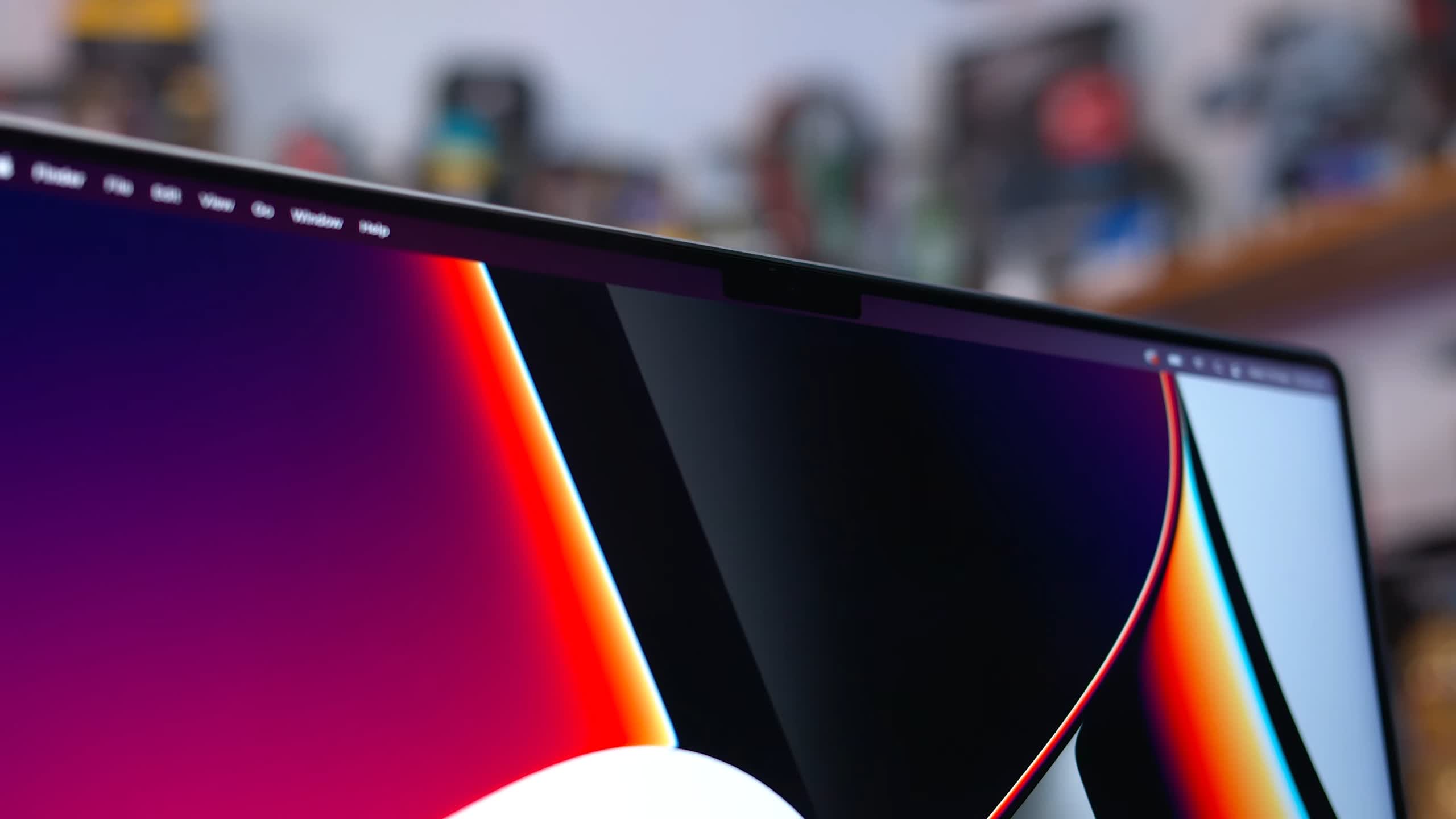
The Liquid Retina XDR display has impressive HDR specifications and operation. A mini-LED backlight zone count of 10,000 is the star of the prove in this respect, significantly reducing blooming compared to other LCD-based HDR monitors, and providing exceptionally high effulgence. The level of performance is good enough for both enthusiast level mastering and HDR playback, so the MacBook Pro is a great device for video editing on the go when you also factor in its overall performance.
A few nitpicks aside, the major downside to the display is motion performance. This display is exceptionally slow even for an LCD, despite packing a 120Hz refresh rate. This affects areas including web browsing and any work with text equally you scroll through content, and mistiness trails can be visible beyond a wide range of apply cases, not just gaming. It's not bad enough to negate the benefits you go elsewhere, merely Apple tree needs to put a lot of work into optimizing how apace their panels transition. I besides feel the lack of HDMI ii.1 on the MacBook Pro is a bit puzzling, going HDMI two.0 for external monitors (in improver to Thunderbolt) is a bit abrasive.

Now comes the ultimate question: is this the best laptop display ever, as Apple claims information technology is? That volition depend on your perspective. Evidently, if you're buying a high-performance laptop for gaming and then no, merely the MacBook Pro is clearly not suited nor aimed at gamers. But if we put that aside and ask almost the best display for content cosmos and productivity, we recollect Apple has a solid claim to that throne.
The only existent competition right at present are OLED panels, which come with their own set of strengths and weaknesses. There are a few other mini-LED laptop options on the Windows side, like the screen you get in the Acer Predator Helios 500, but that display just has 512 zones, not the 10,000 on offer hither. So it's a battle between the MacBook and the OLEDs you come across in products similar the Gigabyte Aero 15 OLED.
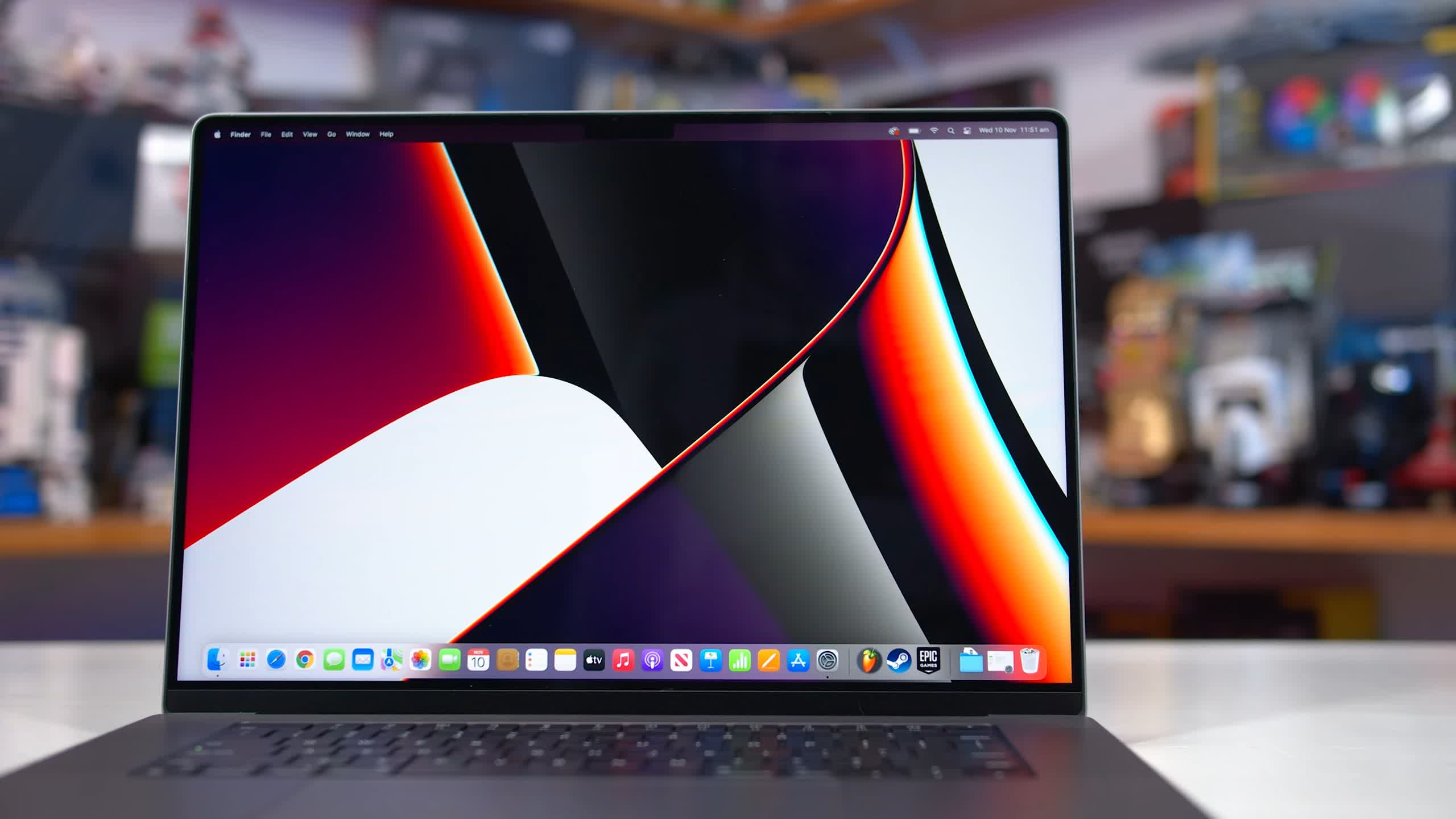
The reasons to get an OLED brandish over this LCD would exist in terms of its self-lit pure HDR feel with null blooming, significantly faster response times for better motion clarity, and wider color gamut allowing for accurate work in the Adobe RGB color space besides as P3 and Rec.709. Even so, the drawbacks are as well significant, including a 60Hz refresh rate limitation with current 4K offerings, the risk of permanent burn down in, and significantly lower effulgence. Actual implementations nosotros've seen also lack the calibration Apple is offering.
On the balance of things, I'd prefer to get the Liquid Retina XDR in the new MacBook Pro than an OLED, especially for color-accurate content cosmos, and the HDR experience is shut enough to OLED that I can forgive very minor blooming on occasion. I wouldn't say Apple is miles in front with this screen, but it's certainly very impressive and calling it the best display for production piece of work is justified.
Shopping Shortcuts
- Apple MacBook Pro 14 on Amazon
- Apple MacBook Pro 16 on Amazon
- Apple MacBook Air M1 on Amazon
- GeForce RTX 3060 Laptops on Amazon
- Ryzen 9 5900HX Laptops on Amazon
Source: https://www.techspot.com/review/2365-apple-macbook-pro-xdr-display/
Posted by: browntherear68.blogspot.com


0 Response to "Apple MacBook Pro's Liquid Retina XDR Display Review"
Post a Comment